#lumad
Explore tagged Tumblr posts
Text




Photographed by BlancSpace Photo House of Polomolok, South Cotabato. Shared by KafyeBlaan Empowerment Inc., 2023.
“Jana Ante Malida's blouse was made by Bai Gulnari Maladianon of Kalyong, a Cultural Heritage Learning Center (CHLC) Instructor at Landan NHS and her tubular skirt is called by the Blaan as Gintlo, a Maguindanaon weave. The Faglung she is holding was made by the late Fulung Doming Maladianon of Kalyong School of Living Tradition of Barangay Landan, Polomolok, South Cotabato.
Jana is the daughter of KafyeBlaan Empowerment Inc. Board of Trustee Dr. Joven Ryan Malida of DepEd Region 12 and Dr. Josseth Malida of Landan National High School.
The photos were taken in celebration of the BUWAN NG WIKANG PAMBANSA.
Jana is 3/4 Blaan and 1/4 Waray cultural roots. She is proudly embracing her cultural identity and diversity.”
#philippines#southeast asia#mindanao#fashion#asian fashion#traditional clothing#x#blaan#lumad#indigenous peoples
21 notes
·
View notes
Text
Davao Today on Facebook:
JUST IN: THE cases of human trafficking against Talaingod Datu Benito Bay-ao and slain Lumad school teachers Chad Booc and Jurain Ngujo II in relation to their custody of Lumad students in Cebu in 2021 were dismissed by Tagum RTC Branch 2.
Judge Jimmy Boco ruled that the prosecution, in this case, police authorities, failed to prove the allegation that Bay-ao, Booc, and Ngujo exploited the Lumad students to join the New People's Army.
via Kath M. Cortez/ DavaoToday
2024 Jun. 24
#junk anti terror law#save our schools#philippines#indigenous rights#lumad#extrajudicial killings#state violence#red tagging#afp-pnp
3 notes
·
View notes
Text
Been seeing that tattoo post around and I'm guessing most of y'all are too white to chime in, so:
Filipino here. I'm not of the cultures that practice tattoos (it was lost to a large part of the country), I'm Tagalog. Closest I could ask about the tattoos was a Cordilleran, which is at least in the same region.
Symbolic tattoos have to look exactly the same to matter. In the example given (the triangles and lines, going around the collar), the tattoos look similar. But not the same, not really. Maybe combining the patterns is part of the culture and that's what they're seeing, but it wasn't clear from the example.
Judkins didn't mention if their artist was indegenous. But Filipinos aren't the only indigenous peoples who used tattoos with geometric patterns (imo the patterns aren't what's too similar, it's the placement on the body). Could be the artist was Filipino, another ethnicity, or white and geometric patterns are just coincidental. Maybe they should've asked before getting worked up.
#wheel of time#someone else chime in#i could be wrong#tagging the peoples#kalinga#cordillera#lumad#sulodnon#butbut
11 notes
·
View notes
Text
in honor of that stupid new deped order...
#gonna change my cover to something special :)#it is so unnecessary man lmfaoo what even are their priorities at this point. 'make it less cluttered' the curriculum is much much more-#cluttered than the classroom decorations could be. how about you focus on that <3333333#make sure to also prioritize the decluttering of the classrooms of the Lumad tribes!! OH WAIT you guys have been shutting their schools-#down since 2016 because tHe cOmMieS aRe rEcRUItiNg you fucking vile fucking rancid red-taggers#i can't. fucking handle this much rage i'm so tired we're all so tired#do we even have to mention the stupid funds they're publicly pocketing at this point. lmao#catdrain
4 notes
·
View notes
Text
Gawad Plaridel Day, Oct. 11, 2023 U.P. College of Mass Communication: Dress Code: Filipiniana of any style and color. OTD, zero-spend, given by clients in solidarity: Daywear, Philippine indigenous Lumad weaves and Philippine indigenous Lumad tubao headgear
Gawad Plaridel Day, Oct. 11, 2023 U.P. College of Mass Communication: Dress Code: Filipiniana of any style and color. OTD, zero-spend, given by clients in solidarity: Daywear, Philippine indigenous Lumad weaves and Philippine indigenous Lumad tubao headgear
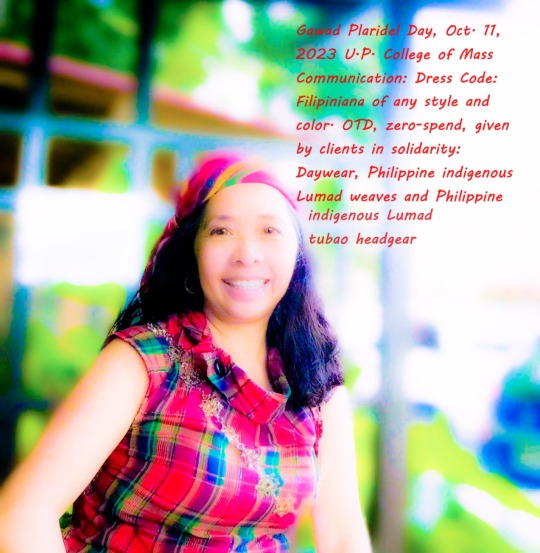
View On WordPress
0 notes
Text
The Fifth Blade: Kampilan - Warrior Made
Down to the last three days before Gubat Banwa launches on Kickstarter! Moon-eating titans, sword-souls and bullet devils, giant flying crocodile mounts, sparks arcing off clashing blades like lightning- Gubat Banwa is an action-packed martial arts TTRPG where you play as warrior Kadungganan in a Southeast Asian-inspired fantasy world afire with wonder and violence in a thousand colors.
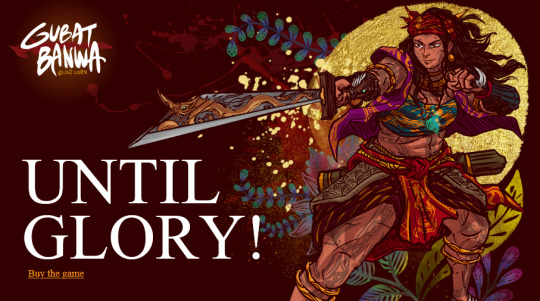
Counting down the days to the KS launch on October 10 comes with anxiety and anticipation in equal measure, and I thought maybe posting the weapons I've drawn for the game would help cut through it all. These were meant to be posted for Swordtember, but the game needed a bit more time to pick up speed. 5/7 blades done, let's start off the final three with the KAMPILAN
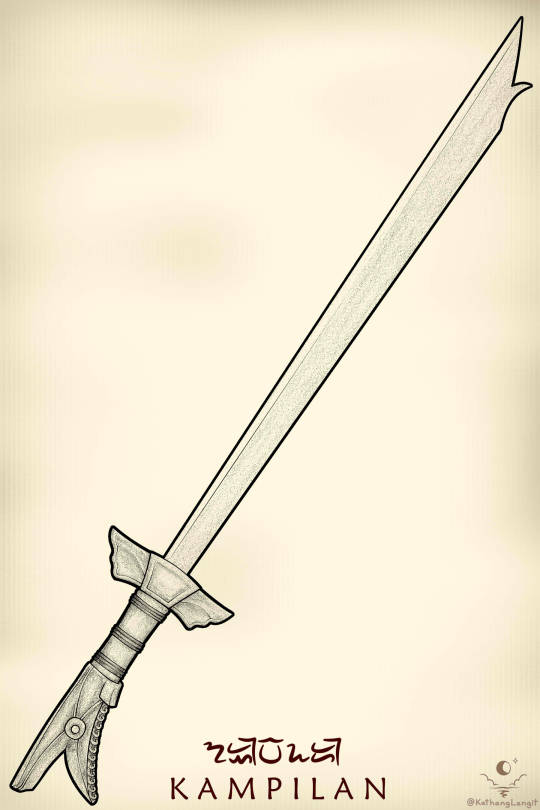
Yet another large weapon from south of Luzon, the kampilan is a long-bladed sword with a unique "trapezoidal" shape, sometimes sporting a small spike at the tip, often with a figural hilt. "Figural hilt" just means the hilt depicts a certain abstracted figure of something, usually a creature or a beast of some kind. The sharpened edge is on the long side of the blade. I repeat: The sharpened edge is on the long side of the blade. You would not believe how frequently people get that wrong. This useful diagram is one of the first things you see when you do a Google-search for "kampilan", so there is truly no excuse for anyone to be depicting it with the sharp side pointing the wrong way.
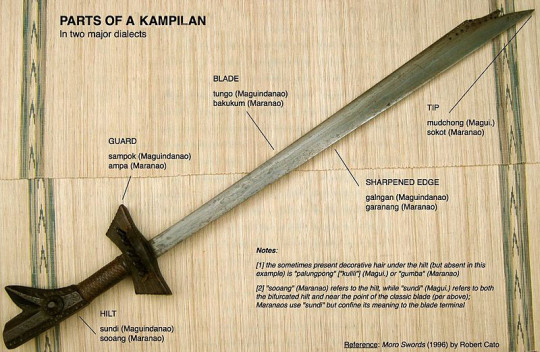
(Diagram by Lorenz Lasco) The most common examples of kampilan figural hilts depict the Bakunawa- a giant moon-eating serpent of legend- and are decorated with hair or with roots. The angled protrusion on the hilt usually points away from the sharpened edge, and may have been used for added leverage when maneuvering the blade.


(Photos from the collection of Ron Zambarrano) Other creatures commonly depicted in the hilts are crocodiles, cockatoos (what collectors call "kakatua" handles), or- in the case of this somewhat rare example- a horse.
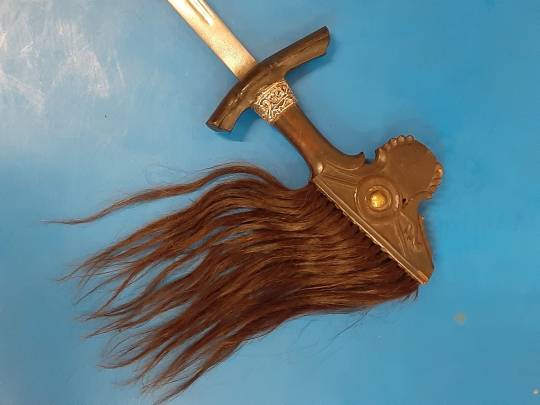
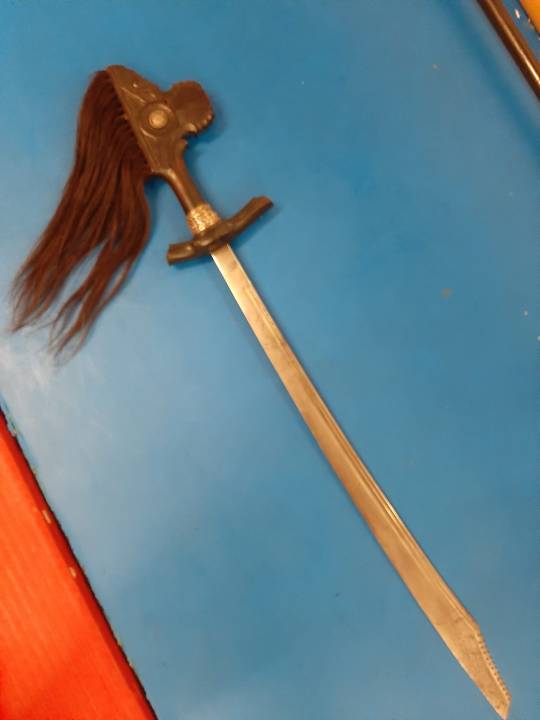
(Photo from the collection of Richard Hudson) The kampilan is surrounded by a rather popular story: That it was the blade used by Lapu-Lapu himself to slay Fernando Magallanes on the shores of Mactan. One of Pigafetta's writings recounts how Magellan was wounded on the leg by a large blade, akin to a scimitar. Whether or not this was describing a kampilan is anyone's guess, and whether it was in the hands of the hero of Mactan is foggier still. While it is difficult to verify the authenticity of this claim, the legend of Lapu-Lapu quickly grew, taking the story with it- and it kind of just stuck.
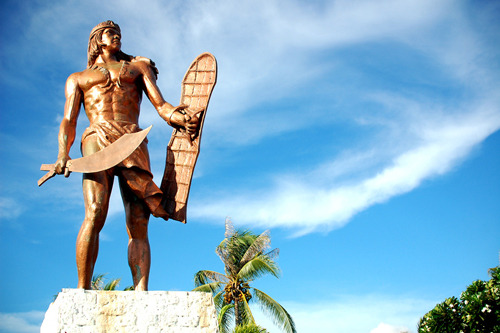
(Photo from Lapu-Lapu City LGU) Most Philippine blades generally vary in size make depending on where they're from, but the distinctions are even more apparent for kampilan. The two-handed ones shown so far are often referred to as Moro kampilan. The Lumad peoples have kampilan of their own.
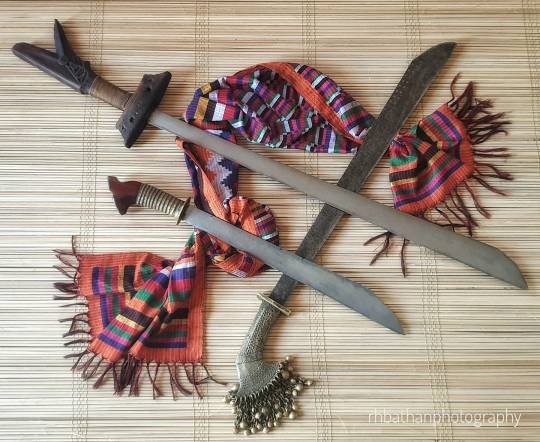
(Photo from Iniingatang Talim At Kaluban.; Taken by Ramon H. Bathan) I'm not an expert on identifying these blades, and this is by no means an exhaustive list (as the kampilan was used widely across Visayas and Mindanao), but I will try to show and identify a few select variants. Starting with this "NICE SHOT"
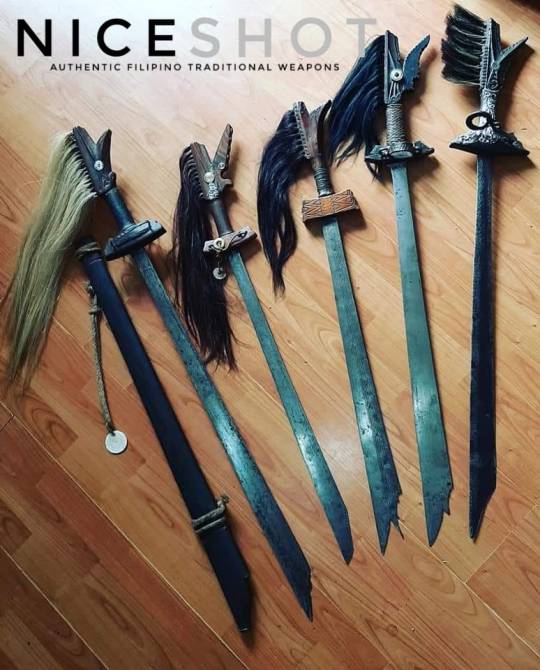
(Various Moro kampilan; Photo by Richard Hudson) Following up with some antique Bagobo kampilan. Notice the difference in size relative to the Moro variant. This seems to be built for one-handed use. You will also notice that the shape of the blade is different, without the spike, and with the sharp edge on the other side.
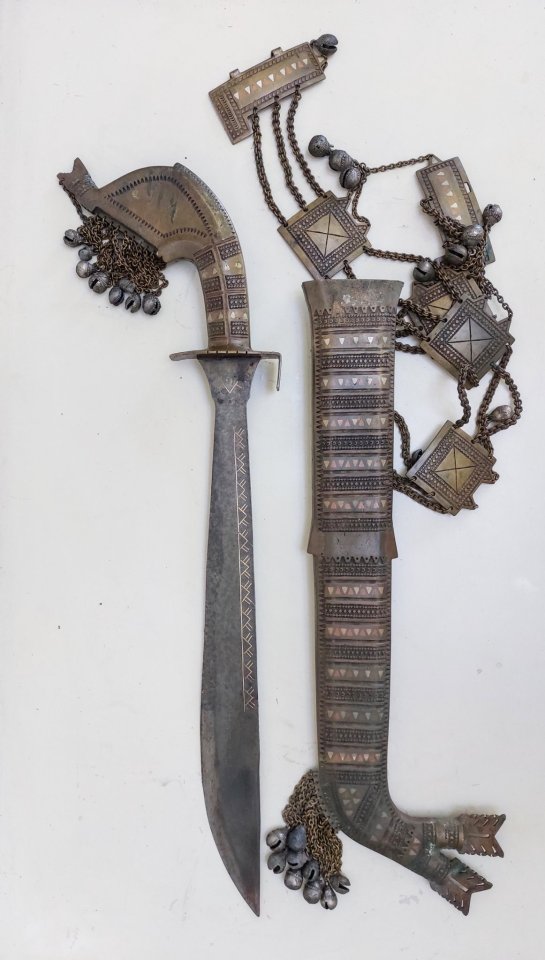
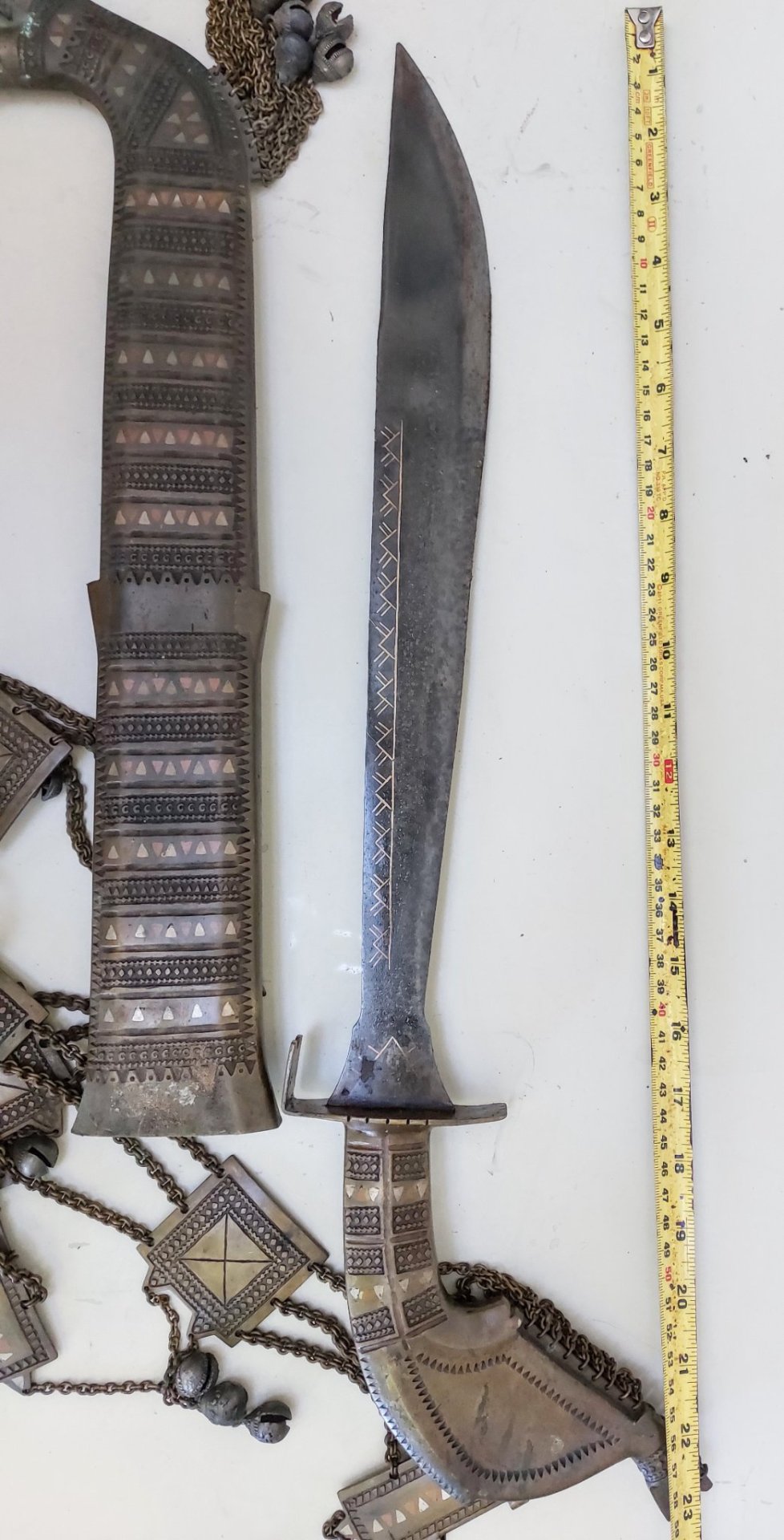
(Photos from Raymundo Lucero) A more useful comparison; These next three blades come from the same collector.
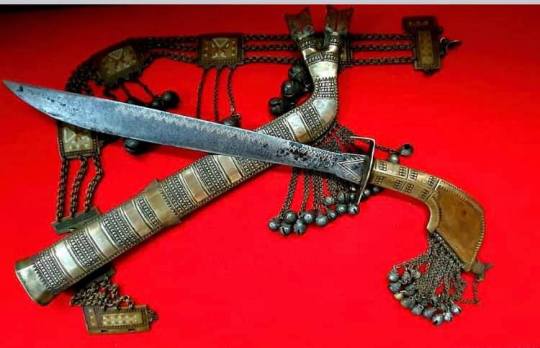
Bagobo kampilan
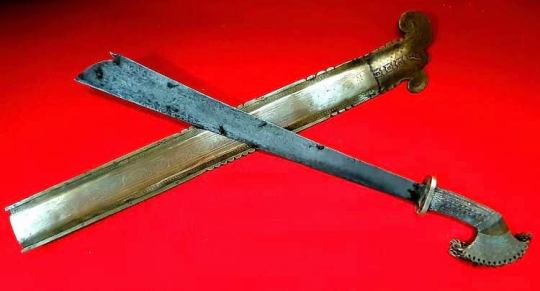
T'boli kampilan or kefilan

Moro kampilan (Photos from Dennis Andrew Golez) Sometimes these blades stray far from home. This next one is a T'boli kampilan inherited by a collector.
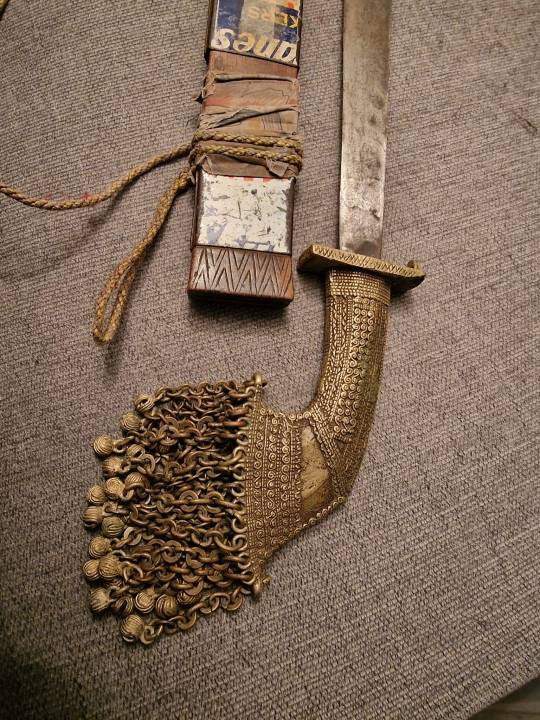
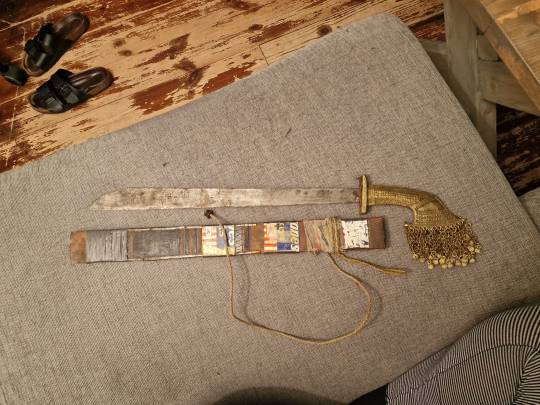
(Photos from Hege-Eileen Ottem Lund) Rather than hair or roots, the Lumad seem to prefer adorning their hilts with brass bells. When you see examples of these blades in museums for up for auction, the bells tend to be absent. I purposefully included examples with bells to show them off in their full ornate glory. "Lumad" is a collective term for indigenous peoples in the south of the Philippines. Another T'boli kampilan, with a closeup on the hilt to show the brasswork.
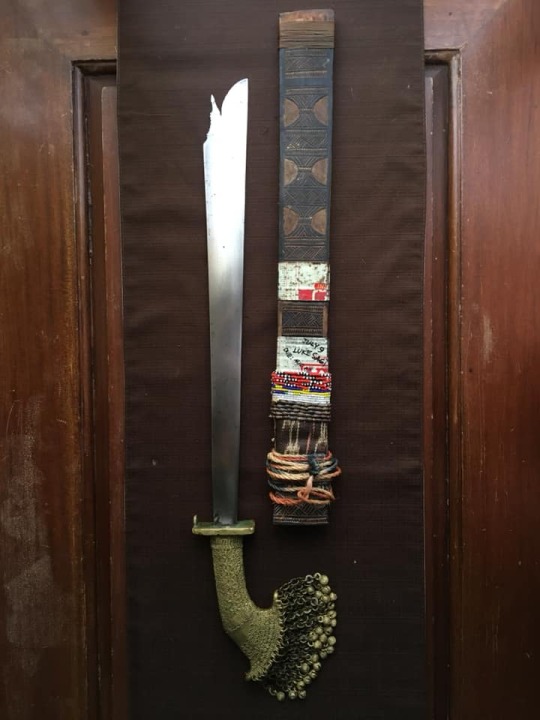
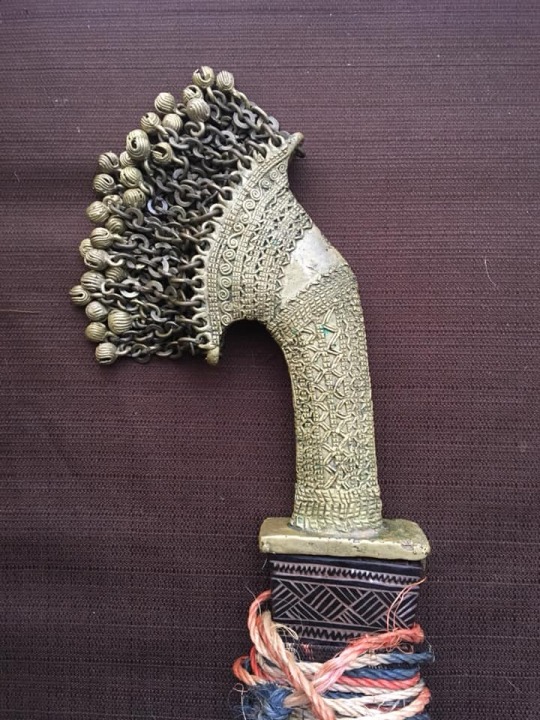
(Photos from JC Nolas) This one's a headscratcher for me- supposedly this unique find from the 1800s has a hilt made of whalebone. The blade looks to be of the Moro variant, but I could very easily be mistaken. It looks to have been adorned with bells as well.
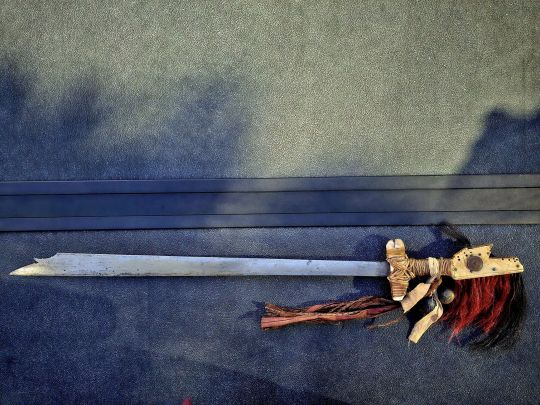
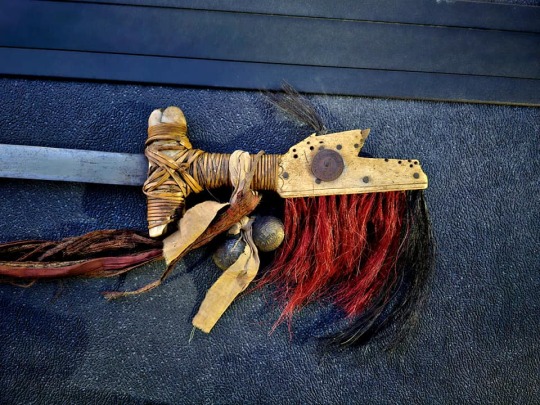
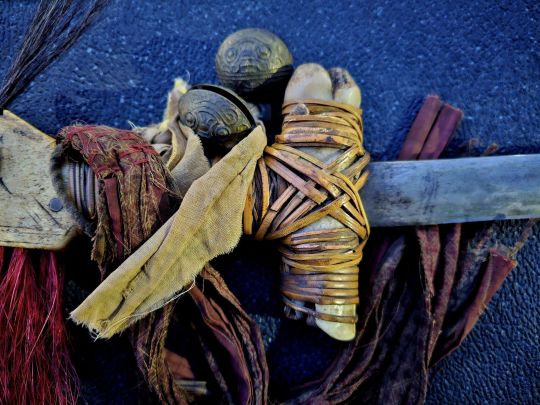
(Photos from Ron Zambarrano) One more thing to note is that the kampilan is not a tool-turned-weapon, nor a multipurpose blade. They are made to be used as weapons. I won't fault anyone for subscribing to the belief that Philippine native blades were mostly farming implements, which just happened to be repurposed for combat sometimes. It is true for many blades which functioned essentially as multi-tools, and the languages sometimes don't help when they use the same word for any kind of blade- be it a tool or a sword. Dispel your myths. Our ancestors were not ALL farmers-turned-fighters. They faced our colonizers as warriors.
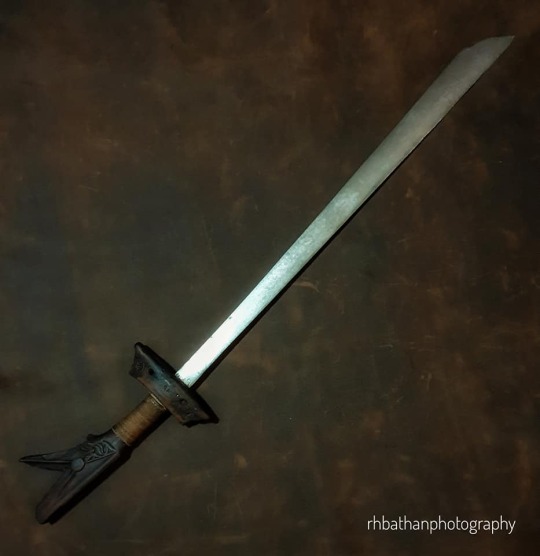
(Photo by Ramon H. Bathan) The veritable force of nature that is Sam'baha (the smug-looking badass in the art at the top of this post) stands as the face of Gubat Banwa, wielding a kampilan in one hand and a karambit in the other. Challenge her legacy! Be a part of all the tide-churning, sky-burning, world-rending action by supporting the game on Kickstarter!
The Gubat Banwa Kickstarter launches in 3 days! Check it out here:
Just three more days for this incredibly small team from the global south to get as many eyes on this project before it launches. We straight up cannot afford Proper Advertising on the scale this game deserves, so we're relying on folks like yourself to help us get the word out. Any help will do! Share it with your friends! Send it to people you think might be interested! Send it to people you know aren't interested! Dump it in that one channel in your friendgroup Discord server that no one has sent any messages to for weeks now! Reblog this even if you didn't read the post at all, we won't tell!
#gubat banwa#gamedev#ttrpg#ttrpgs#indie ttrpg#indie ttrpgs#tabletop rpgs#rpgs#rpg#southeast asia#southeastasia#dnd#kickstarter#swords#philippine blade#weapon design#philippine history#philippine culture#filipino artists#artists on tumblr#kathang langit#help us get the word out!#fantasy#fantasy worldbuilding#swordtember#moro weapons#moro blades#kampilan#bagobo#t'boli
121 notes
·
View notes
Text




Miss Supranational Philippines 2023 National Costume
This custom red Filipiñana is created in a classic sillhouette, following the traditional draping and '70s sophisticated butterfly sleeves. A voluminous cascading train is attached to epitomize the daintiness of a Filipina. It is adorned with intricate embroidery details with bead works and paired with a traditional umbrella that is decorated with sparkly 'Okir' patterns. Okir or okil is the term for rectilinear and curvilinear plant-based designs and folk motifs that can be usually found among the Moro and Lumad people of the Southern Philippines, as well as parts of Sabah.
#Miss supranational#Miss supranational philippines#Philippines#pageant#national costume#national costume contest
90 notes
·
View notes
Text
She Was Courage, Strength, and Commitment: A Tribute to Trans Woman Revolutionary Dee "Ka Dahlia" Supelanas
My last memory of Dee was when she agreed to emcee for the journalism workshop of alternative media organization Aninaw Productions. I was the head editor then and organizing the workshop was challenging as this had been in 2021 and travel was still restricted due to COVID—not to mention my own limitations as a lupus patient—so the whole 3-part workshop had to be held online.
This was a very stressful time for me as I was approaching the final exams for the first semester of my master's degree, alongside continuing my organizing and journalism work virtually.

But Dee had a way about her, an aura that just put you at ease. So when she agreed to the task—and even assisted beyond that—I knew we would be alright.
Dee had a soft nature at first look, but once you got to know the firm student leader, you couldn't ever question the authority in her voice, her sharp analyses, and the way she held herself. Her conviction in her willingness to learn and improve in her work as an activist and organizer could not be denied.
Dee was a year younger than me and a fellow student at UP Cebu. She was part of the first batch of freshmen who underwent the K-12 program and had only entered college as my batch started our senior year. With three years between us, UP Cebu's population was smaller than it had been. This presented a challenge with organizing, but Dee and her fellow student leaders at that time held strong and persevered because they knew victories aren't won overnight. From the beginning, Dee had always showed dedication to serving the student population and other sectors outside the university.
I'd worked with her in multiple campaigns. There were many nights spent poring over the best ways to get things moving. We worked together during the 2019 Lumad Bakwit School, supporting the Lumad indigenous groups as they evacuated (bakwit) from the rampant militarization and bombing of their homes and schools. State forces are constantly making way for multinational corporations to steal from the resource-rich ancestral lands. The Lumad launched the Bakwit School as both an effort to continue Lumad children's education amid the horrors of imperialist plunder and as their way to show their resistance against militarization. While I was the person working behind the scenes, Dee was one of the representatives from the youth sector leading the charge as we marched alongside the Lumad people. We were there, too, when the police raided the Lumad Bakwit School in 2021 and Lumad volunteer teachers, Lumad leaders and students alike were unjustly arrested. We fought hard to ensure the safety of the Lumad children, who were being paraded around in the media by the police like trophies for their "successful" operation.
We also worked on several other campaigns together across multiple sectors, including human rights, education, labor, and LGBT rights campaigns. Part and parcel of our work as activists is the exposure to how the rotten system continuously fails and oppresses the marginalized. Dee bore witness to the struggles of farming and peasant communities in Negros Oriental when she joined the fact-finding mission that human rights organizations led into Oplan Sauron where 14 farmers were almost simultaneously killed across the island by combined military and police forces, for simply being under the mere suspicion that they were armed rebels. She saw how the education sector struggled—teachers, students, and support staff alike—as a student leader. She supported unions and workers' associations, and fought alongside fellow advocates for gender equality, an advocacy close to her heart as Dee herself was a trans woman.
As a victim of red-tagging and death threats herself, Dee saw how state forces consisently showed absolutely no respect for the rule of law and how a broken justice system enabled this.She was also familiar with the maneuvers of corporations and the ruling elite who back them to purposely raze urban poor communities to the ground to make way for greed disguised as development. Dee understood that this "development" was paid for by the displacement of the working class, most earning less than minimum wage and struggling with job insecurity.
Dee sat, spoke, ate, marched, and fought alongside the marginalized, the exploited, and the oppressed. Here, she learned the might of collective action and the power of revolutionary fervor so strong, those in power could not help but bend to it. Dee saw that the basic masses, even with everything up against them and everything to lose, still continued to fight people and institutions more powerful than them because it was just and necessary. Dee did not come to the decision to join the armed revolutionary movement lightly. I hadn't been able to see her in years, but this much I know is true. She chose to die serving the people, in the way she believed was most effective. She could no longer stand by and watch as our government stole from, tricked, and killed us. A drastic change was needed.
Dee was one of our best and brightest and, most importantly, kindest. It wasn't the type of kindness that folded in on itself, but one that reached out and touched people, one that didn't limit itself. She was fierce and gentle all at the same time. She was scary at times, but was also the first to laugh unapologetically at the bad jokes and the first to offer a genuine smile. She was courage, strength, and commitment.
At 26 years old,Dee was killed along with 6 other Red fighters on April 27, 2025 in a rural area in Cabancalan City, Negros Occidental.'
I wish I could tell you all about the vibrant life she led until the day she died, but no online space can truly contain all that Dee was and has ever been.
I love and miss you, Dee. I wish I could have seen you one last time. Rest in power, Ka Dahlia! ✊🏼
———
Dee, I wish I could have given you a better tribute more fitting of the wonderful and fierce woman that you were, but my blindness is in the way. I just know you would say, "Okay ra te uyyyy" if you heard me right now. You always had a way of keeping us in line. I miss your wisdom dearly.
Read on Medium
4 notes
·
View notes
Text



Why did I choose nursing? (Entry No. 1)
I write this entry almost halfway through my journey as a student nurse. Most of my life has practically revolved around nursing and everything that goes with it by now, almost 2 years since my journey started. However, I really find it funny whenever I reminisce back when I was still in my early teens till I was about 16 because if I told that version of me that I was a nursing student, they would have had their jaw dropped on the floor in disbelief.
If you asked me what I wanted to be when I grew up back then, my answer would have been, without question, an attorney at law. I was raised by mother, who is a doctor, and my grandfather, who used to be a lawyer. Growing up, I would listen to my grandfather talk about his cases and see him help other people in far-flung areas with their legal troubles. I saw it as a great way of serving people. And when I do listen to him talk about it, it always felt interesting and it always peaked my interest. My grandfather still tells me to this day that if I were to start reading criminal law (I still haven't, but he gave me his copy of it), I would actually love it. Because of that, for most of my 20 years in this earth, I aspired to become a lawyer just like him. It actually came to a point where I was not even trying to excel at my Math and Science subjects in Junior High School because I was so sure that I wouldn't go for a science degree by the time I reached college. I planned on going for courses such as History or Political Science by the time I got to college because those were the courses that I knew I was good at. I excelled at my history classes and was (and still is) very interested in the subject of politics. I just know if there is an alternate universe, like the ones you see in the new Marvel movies, there really would be a universe where I picked Humanities and picked a Humanities-related course when college came.
So, if you read all that, you might be thinking, how on God's green earth did I end up as a nursing student? If I was so hell-bent on pursuing law, then why'd I pick a course that is so far from it?
It all started in 2020; this was on the final week of the school year, which was what we called "clearance week". I didn't have to go to school anymore because I had finished all my requirements and was ready to spend my summer vacation; that's when the news broke out that Davao was to do a 2-week quarantine. Those 2 weeks turned to months without going outside, and the last school year was to be done online. During the quarantine, it gave me time to think and reflect on a lot because I had a lot of time to reflect and think about what I was going to do with my life. It was also at this time when I had doubts about proceeding with the law due to politics and the incidents I've read and seen online where 2 human rights lawyers were murdered in cold blood for defending Lumad ancestral domains. It really did scare me and it gave me doubts if I wanted to proceed with my path. It was also at this time when I got inspired by the doctors and the nurses, along with many of the healthcare staff working in the front lines to fight covid and I had began to take interest in having a career in Healthcare because at the end of the day, If i end up being a lawyer, or a nurse, or a doctor, my intention stays the same, as long as I can serve the people, then I will be satisfied with my profession. And that's when I had the idea of taking nursing in college. My biggest reason for picking nursing is so that I can really determine if I want to work in Law or in Healthcare so that by the time I finish college I can decide if I want to go to law or med school or work as a nurse. Nursing is also very hands-on, and I tend to learn better through that method of teaching.
I can't say that the last two years have been easy for me; as I said earlier, I never really took my science subjects seriously in high school so that gave me a slight disadvantage when it came to my anatomy and biochemistry classes back in first year. Those were really dark days for me and it made me doubt my capabilities and knowledge to be honest. There were times I really told myself that if I was in a humanities course, I would be thriving or even excelling at that point. But I still continued because I told myself that once I reached 2nd sem, it would be so much easier since I'd be able to appreciate nursing since the subjects were all nursing-centered. And I was right, once it reached second sem and all the subjects focused on nursing, I thrived, I loved it, and the hands-on experience made it very easy for me to learn. And now, as I near the midway point of my second semester of my 2nd year, with more experience in the classroom and in the hospital, I have no regrets choosing this course, I have grown as a person and as a student over the duration of my time here and I have met some of the best people that inspire me to be better. I still don't know where my path takes me, I still don't know if I'll choose healthcare or law, I still don't know my destination, but I know one thing for certain, this path I chose, is the right path.
4 notes
·
View notes
Text

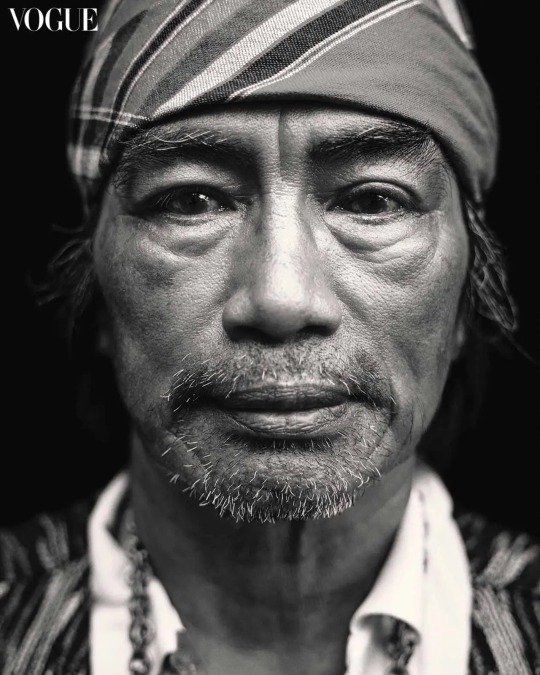
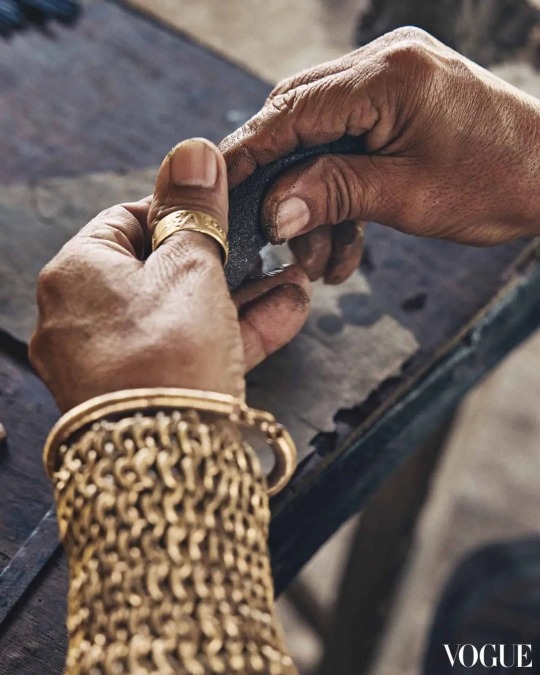
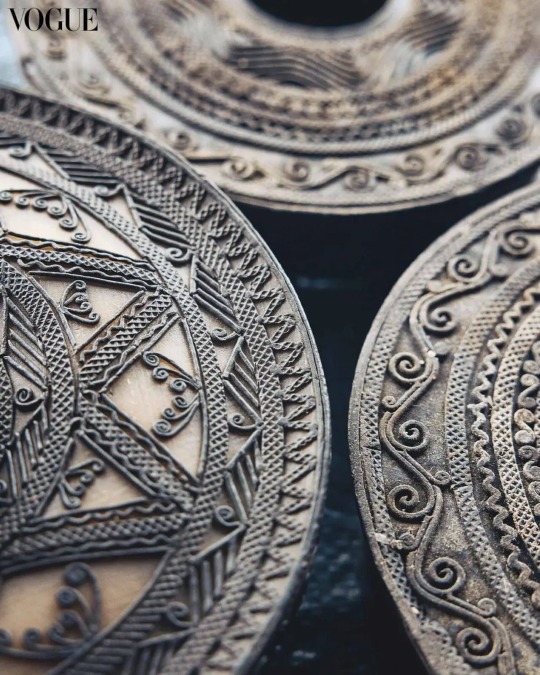
Photographed by Gabriel Nivera for the May 2024 Issue of Vogue Philippines.
[Bundos Bansil Fara] is one of the three Tboli artists who were recognized as Manlilikha ng Bayan (GAMABA) or National Living Treasures in December 2023. The award is given to Filipinos whose “distinctive skills have reached such a high level of technical and artistic excellence and have been passed on to and widely practiced by the present generation.” … This is the first time a brass caster has been awarded since the GAMABA’s inception in 1992.
Brass casting is a skill learnt from one’s forebears, and Fara’s father and grandfather were all metalworkers. “I started in the process of brass casting when I was eight years old,��� Fara says. Now 58, he has been working with molten materials for half a century. “My eyesight has gotten blurry.” Fortunately, he has a team of four sons working with him—one will be melting the wax, a mixture of beeswax, candle wax, and asphalt that forms a black putty; another will be tending to the blazing hot fires, fanning coals inside two holes in the ground, one for melting the metals, another for firing the clay molds.
Ginton is the Tboli god of metallurgy and the son of the supreme being Dwata. It is believed that he gifted the people with brass anklets, chain belts, rings, and swords—all of which still intricately adorn, protect, and tell the story of the Tboli today. As for the beginnings of brass, Fr. Gabriel Casal notes in his book T’Boli Art in its Socio-Cultural Context (1977), “The T’bolis give no indication of having ever possessed any knowledge of mining their own metals. These, they seem to have always obtained from old broken agong (gongs) or any of their other metal objects that break, and which they melt and re-employ for new substitutes.”
The recycling/upcycling of metals is still how Fara and other brass casters source their materials today. “We would melt down old gongs to create new items, but now there are many other things we can find at the junk shop, like padlocks, bullet shells, pipes.” The products they make are not strictly made of brass, but an alloy of brass, bronze, steel, and whatever else can be liquified in Fara’s smoldering hot pot.
(READ: Metal In The Blood: GAMABA Awardee Bundos Fara On The Craft Of Brass Casting by Audrey Carpio)
#mindanao#philippines#southeast asia#tboli#t’boli#metallurgy#indigenous peoples#lumad#lake sebu#vogue#fashion#x
117 notes
·
View notes
Text
The openness of Filipino Christians to struggle for national liberation, as shown by the Filipino Catholic clergy who joined the revolution against Spanish colonialism, and even to Marxism . . . had led US imperialism to continue commissioning the CIA to persist in utilizing the Christian religion to hide the exploitation and oppression of US imperialism in the Philippines. For instance, the CIA initiated the entry of Christian “socialism,” which became the ideological foundation of the Christian Social Movement (CSM) headed by Manglapus and Manahan among pro-US imperialist politicians to counter Filipino nationalist politicians, led by the late Senator Claro M. Recto. Senator C. M. Recto was a staunch anti-US imperialist critic and was believed to have been a victim of the CIA, as he died mysteriously of heart attack, though he had no known heart ailment, in Rome, Italy after an appointment with two Caucasians in business suits in 1958. During the 1960s to the 1970s, the CIA established the Campus Crusaders for Christ (CCC) in various universities and colleges throughout the Philippines; the New Tribes Mission (NTM) stations and the Summer Institute of Linguistics (SIL) centers were formed by the CIA in the mountainous areas of the national minorities throughout the Philippines. And since the 1980s up to the present period, all sorts of CIA-backed charismatic congregations, the Dating Daan of Eli Soriano, the Sonship Kingdom of Pastor Apollo Quiboloy (a megalomaniac and self-appointed Son of God in Davao and a friend of tyrant Duterte; has expropriated Lumad lands; owns Son Shine Radio with 16 transmitters stationed strategically throughout the country, fully supports tyrant Duterte’s Build, Build, Build projects; and actively participates in the surrender campaign of the National Task Force to End Local Communist Armed Conflict or NTF-ELCAC), “praise the Lord” groups, “Christ to the Orient” and “free believers” have proliferated. And usually, the use of the Bible and Christianity for the CIA-backed evangelists is to attack the mainline Christian Churches that adhere to human rights in Philippine society.
A Commentary on the Compendium of the Social Doctrine of the Church – Christians for National Liberation
7 notes
·
View notes
Text
EP-Variowd: The Ultimate Solution for Dental Hygiene

Discover the EP-Variowd, a state-of-the-art dental scaler designed for professionals who demand precision and reliability. With its advanced technology and ergonomic design, the EP-Variowd ensures optimal cleaning and patient comfort during dental procedures. Ideal for removing calculus and plaque, this versatile tool offers customizable settings to suit a variety of patient needs. Visit LumaDent to learn more about how the Ergo Prism-Variowd can enhance your dental practice and improve patient care with its powerful yet gentle performance.
3 notes
·
View notes
Text
Post originally from: Tinig ng Plaridel (Facebook) - Translated to English
PHOTOS: Various indigenous groups and Indigenous Peoples (IP) rights advocates gathered at the College of Social Work and Community Development (CSWCD), University of the Philippines: Diliman to commemorate the life and legacy of Bai Bibyaon Ligkayan Bigkay yesterday, June 5.
One of the first female leaders of the Manobo-Matigsalog tribe, Bai Bibyaon is famous as a defender of the rights of women, youth, ancestral lands and nature.
The program features cultural performances from various groups, with the goal of continuing the messages and legacy left by Bai Bibyaon. "May his eternal legacy be a beacon to the Lumads and other natives," said Eufemia Cullamat of the SANDUGO alliance.
In 2017, the UPD CSWCD honored Bai Bibyaon with the Tandang Sora Award for his fight for the rights and welfare of the Lumad.
Photo by Richardson Tubo
#LongLiveBaiBibyaon
#DefendAncestralLands
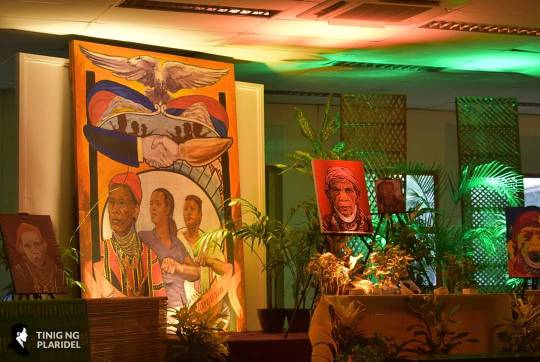

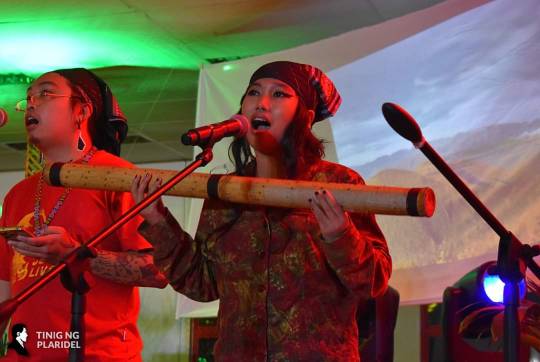
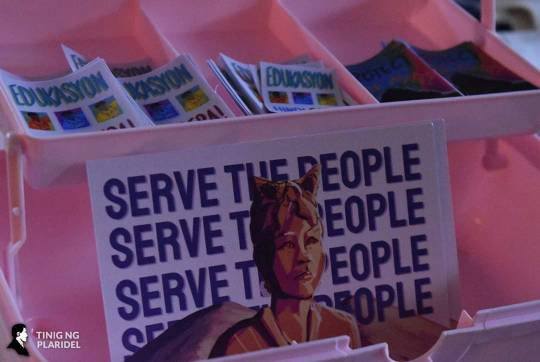
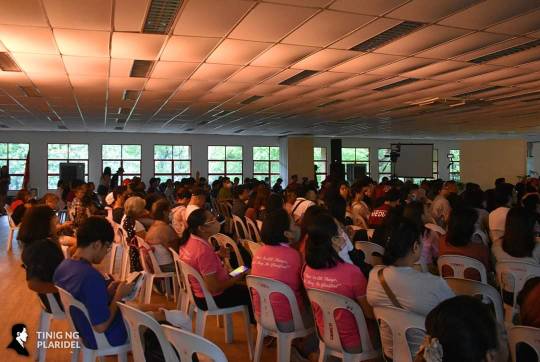
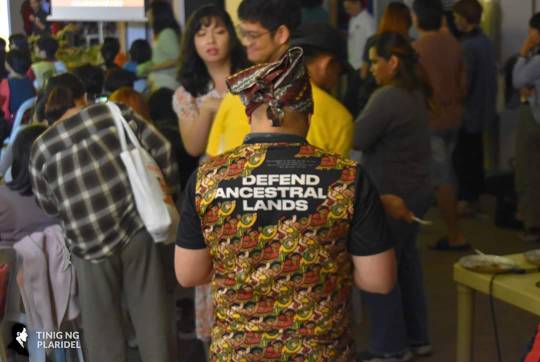
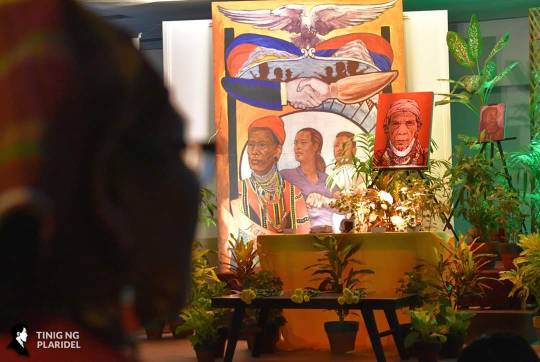

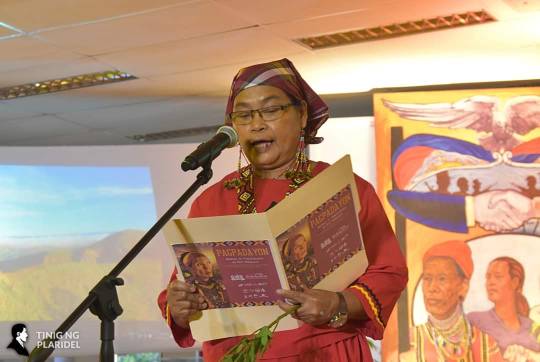
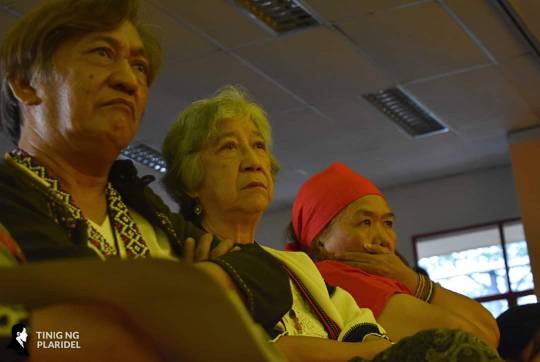
More photos on the link above, Tumblr has a photo limit on each post. Will also reblog with those other photos
4 notes
·
View notes
Text
that still of chris’ bedroom with the boyband poster but instead of the lumadeers or whatever its august moon
2 notes
·
View notes
Text
The script paraphrases and arranges Imelda’s real quotes into lyrics, creating a bare-faced critique of her philosophy and exploitation of poverty—the show’s title is taken from a 1987 interview in which Imelda and Ferdinand are asked what they’d like their epitaph to read: “One word,” said Imelda, “Love.” By also citing the U.S. support of the Marcos regime (Reagan’s administration helicoptered them to Hawaii after they were expelled) the show bemoans the ongoing normalization of U.S. interference in the Philippines.
The historic all-Filipino cast is a powerhouse, especially the corps ensemble. Conrad Nicamura’s interpretation of senator Benigno “Ninoy” Aquino, the Marcos’s foremost opposition leader, grounds viewers against an otherwise dark history. Imelda, played by Arielle Jacobs, may be the main character, but Ninoy is the show’s hero as the only voice calling for democracy and disrupting the couple’s ascent to power.
While the show succinctly highlights Imelda’s cruelty, the hour and a half time constraint reduces the topic’s complexities. The People Power Revolution is reduced to a procession of protest effigies in the dark on the far end of the dancefloor from Imelda, who pleads in the spotlight, “why don’t you love me?” A brief scene of police brutality and flashing headlines reveal some of the Marcos’s most heinous abuses: 3,200 killed; 34,000 tortured; and over 70,000 imprisoned. Still, the show ends with a powerful ensemble protest song representing the movement, its chorus declaring: “God draws straight, but with crooked lines.”
Consistent interweaving might have offered more equitable representation between the 1% and commonfolk. The erasure of Indigenous Lumad and the leadership of women in the resistance must also be considered. The former becomes more apparent when one notes how few dark-skinned Filipinos were cast.
By Rohan Zhou-Lee
#here lies love#perspective from a Black Filipino reviewer#musicals#broadway#imelda marcos#People Power Revolution#There's other criticism by Filipino writers who actually SAW the show#The opinions on this musical (those who actually saw it) aren't monolithic either
4 notes
·
View notes
